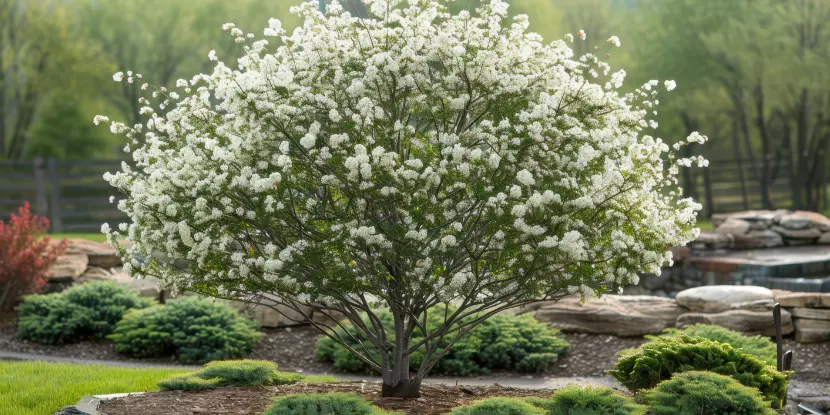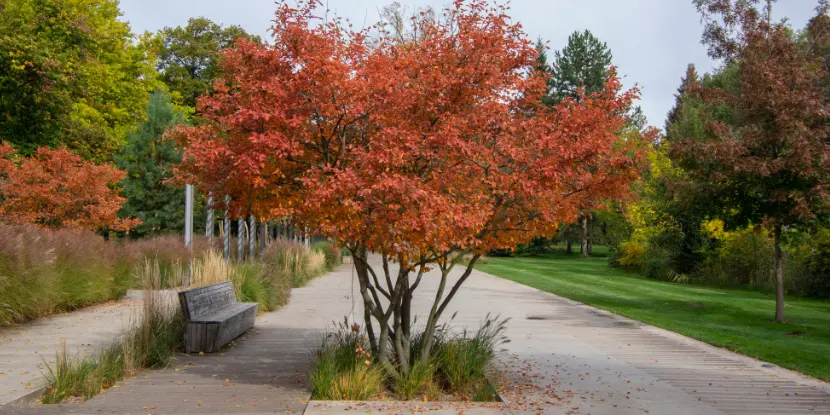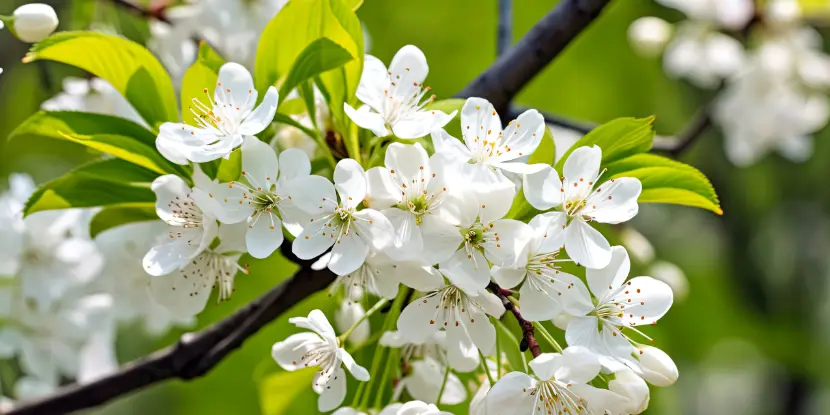The serviceberry tree (genus Amelanchier) bears spectacular white flowers in early spring, followed by sweet, blueberry-like fruit in the summer. Its fall foliage turns brilliant shades of orange and red.
Varieties of this North American plant range from small shrubs to tall trees. Indigenous Americans used the serviceberry fruit for medicinal purposes, and it was a significant food source for early European settlers.
Choosing Your Serviceberry Tree
There are 20–30 species of serviceberry trees. Notably, at least one species is native to every US state except Hawaii and every Canadian province and territory.
Smaller varieties like the Saskatoon or Dwarf Shadblow are well-suited for urban gardens, while taller trees like the Allegheny Serviceberry make striking accents in larger landscapes.
Southern California’s benign climate is friendly to several serviceberry varieties, including:
- Utah Serviceberry (Amelanchier utahensis): Native to the western United States, including California, this species is well-adapted to arid conditions. It typically grows as a shrub or small tree, reaching heights of 6 to 15 feet.
- Western Serviceberry (Amelanchier alnifolia): Also known as Saskatoon serviceberry, this species is native to western North America. It typically grows as a shrub or small tree, reaching up to 10 feet in height and width.
- Allegheny Serviceberry (Amelanchier laevis): This species grows to 25 feet with a similar width. It features smooth leaves with a gorgeous reddish tint in spring and adapts well to warm climates like Southern California’s.
- Saskatoon Serviceberry (Alanchier alnifolia): A small tree/shrub hybrid that supports white blooms in spring, edible purple berries in summer, and orange leaves in fall.

A blooming serviceberry tree in springtime.
Ideal Growing Conditions
Light Requirements
- Serviceberry trees need at least 4–6 hours of direct sunlight daily.
- Some varieties, such as the Allegheny Serviceberry, can tolerate more shade.
Temperature
- Though native to cooler climates, many serviceberry varieties adapt well to Southern California’s mild winters and hot summers.
- Avoid extreme heat conditions, which can stress the tree.
- Consider positioning your tree in an area with some afternoon shade.
Soil
- Serviceberry trees grow best in well-drained, slightly acidic soil with a pH between 5.5 and 7.0.
- They can tolerate clay or loamy soils with adequate drainage.
- Before planting, amend the soil with compost and organic matter for healthy growth.
Planting Your Serviceberry Tree
Planting in the fall allows the roots to establish before winter. Early spring planting ensures the tree has the entire growing season to develop strong roots and foliage.
Avoid planting during the hot summer; the heat can stress young trees and hinder root development. A cool, mild day gives your serviceberry the best chance for success.
- Choose a location with good sun exposure, well-draining soil, and enough space for your serviceberry variety to reach its full height and width.
- Dig a hole twice as wide and deep as the tree’s root ball.
- Gently remove the tree from its container and loosen any tightly bound roots before placing it into the hole.
- Position the tree in the hole, ensuring the root flare (where the roots meet the trunk) is level with the ground.
- Fill the hole with nutrient-rich soil and water thoroughly. This helps eliminate air pockets around the roots.
- Mulch around the base to retain moisture and regulate soil temperature, but keep mulch away from the trunk to prevent rot.

The bright autumn colors of Amelanchier lamarckii.
Serviceberry Tree Care
Watering
Serviceberry trees need consistent moisture, especially during their first couple of years.
- Water weekly during dry periods, ensuring the soil remains moist but not soggy.
- Mature trees withstand drought better, but periodic deep watering boosts fruit production.
Fertilizing
- Feed your tree with a balanced, slow-release fertilizer in early spring to support its flowering and fruiting.
- For organic options, use compost or well-rotted manure.
Pro Tip: Avoid over-fertilizing; excess nitrogen can lead to excessive foliage growth at the expense of flowers and fruit.
Pruning
Pruning is essential to maintain shape, promote airflow, and prevent disease:
- Remove dead, damaged, or crossing branches during late winter or early spring before new growth starts.
- Thin the tree’s canopy to improve light penetration and encourage healthy fruit production.
Pro Tip: Sterilize pruning tools between cuts to prevent the spread of disease.

Closeup of serviceberry blossoms.
Pests & Diseases
Serviceberry trees are relatively pest-resistant, but no plant is immune:
- Aphids, scale insects, and borers can harm the tree. To manage infestations, use insecticidal soap or horticultural oils.
- Watch for rust, powdery mildew, and fire blight. Promote good airflow around the tree and apply fungicides if needed.
Harvesting Fruit
Serviceberry fruit reaches maturity in the summer, typically between June and August.
The flavor is like a blend of blueberries and sweet cherries with a hint of almond-like nuttiness. The berries are soft, juicy, and packed with natural sweetness.
- Harvest ripe berries when their color deepens to dark blue-purple.
- Avoid picking unripe fruit; they’re tart and can cause stomach upset.
- Enjoy the fruit fresh or freeze it for later use.
You can eat the berries fresh or cook them in pies, jams, muffins, and scones. You can blend them into smoothies, add them as a topping, or pair them with savory dishes.
Feeling lazy? Leave the fruit on the tree for birds to enjoy. There will always be more for you later!

Saskatoon bush in late summer with clusters of ripe berries ready for harvest.
FAQs: Serviceberry Tree Care
Q: Can I grow a serviceberry tree in a container?
Smaller varieties like Canadian Serviceberry are suitable for containers. The pot should have good drainage and be large enough for root growth.
Q: How soon will my serviceberry tree bear fruit?
Depending on the variety, most serviceberry trees begin producing fruit within 2 to 4 years after planting.
Q: Are serviceberry fruits edible?
The berries are not only safe to eat but also delicious. They’re great in pies, jams, or eaten fresh.
Q: How tall do serviceberry trees grow?
Serviceberry trees range from 4 to 30 feet. Choosing the right variety will depend on your landscaping needs and space availability.
Q: Can I plant a Serviceberry tree in clay soil?
Yes, but the soil must drain well. To improve drainage and aeration, amend heavy clay soil with compost.
Q: When’s the best time to plant a serviceberry tree?
The ideal time to plant a serviceberry tree is in early spring or fall when the weather is cooler. This gives the tree time to establish its roots before the stresses of summer heat or winter cold.
Q: How do I know if my serviceberry tree gets enough water?
Check the soil around the tree regularly. It should feel moist but not soggy. If the leaves start wilting or turning yellow, it may indicate insufficient watering. Aim for consistent moisture, especially during dry spells or the tree’s first two years.
Q: Do serviceberry trees need cross-pollination to produce fruit?
While serviceberry trees are self-pollinating and can produce fruit on their own, planting multiple trees can improve fruit yield and quality. Bees and other pollinators can also boost the process.

